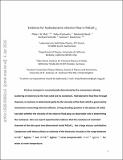Files in this item
Evidence for hydrodynamic electron flow in PdCoO2
Item metadata
| dc.contributor.author | Moll, Philip J.W. | |
| dc.contributor.author | Kushwaha, Pallavi | |
| dc.contributor.author | Nandi, Nabhamila | |
| dc.contributor.author | Schmidt, Burkhard | |
| dc.contributor.author | Mackenzie, Andrew | |
| dc.date.accessioned | 2016-02-18T15:40:16Z | |
| dc.date.available | 2016-02-18T15:40:16Z | |
| dc.date.issued | 2016-03-04 | |
| dc.identifier | 240104887 | |
| dc.identifier | 82211467-8c94-4860-9a93-50a6cd7676f9 | |
| dc.identifier | 84960330703 | |
| dc.identifier | 000371597500038 | |
| dc.identifier.citation | Moll , P J W , Kushwaha , P , Nandi , N , Schmidt , B & Mackenzie , A 2016 , ' Evidence for hydrodynamic electron flow in PdCoO 2 ' , Science , vol. 351 , no. 6277 , pp. 1061-1064 . https://doi.org/10.1126/science.aac8385 | en |
| dc.identifier.issn | 0036-8075 | |
| dc.identifier.uri | https://hdl.handle.net/10023/8262 | |
| dc.description.abstract | Electron transport is conventionally determined by the momentum-relaxing scattering of electrons by the host solid and its excitations. Hydrodynamic fluid flow through channels, in contrast, is determined partly by the viscosity of the fluid, which is governed by momentum-conserving internal collisions. A long-standing question in the physics of solids has been whether the viscosity of the electron fluid plays an observable role in determining the resistance. We report experimental evidence that the resistance of restricted channels of the ultrapure two-dimensional metal palladium coboltate (PdCoO2) has a large viscous contribution. Comparison with theory allows an estimate of the electronic viscosity in the range between 6×10–3 kg(ms)–1 and 3×10–4 kg(ms)–1, versus 1×10–3 kg(ms)–1 for water at room temperature. | |
| dc.format.extent | 5 | |
| dc.format.extent | 3783933 | |
| dc.language.iso | eng | |
| dc.relation.ispartof | Science | en |
| dc.subject | QC Physics | en |
| dc.subject | DAS | en |
| dc.subject | BDC | en |
| dc.subject | R2C | en |
| dc.subject.lcc | QC | en |
| dc.title | Evidence for hydrodynamic electron flow in PdCoO2 | en |
| dc.type | Journal article | en |
| dc.contributor.sponsor | EPSRC | en |
| dc.contributor.institution | University of St Andrews. School of Physics and Astronomy | en |
| dc.contributor.institution | University of St Andrews. Condensed Matter Physics | en |
| dc.identifier.doi | 10.1126/science.aac8385 | |
| dc.description.status | Peer reviewed | en |
| dc.identifier.url | http://www.sciencemag.org/cgi/content/full/science.aac8385/DC1 | en |
| dc.identifier.grantnumber | EP/I031014/1 | en |
This item appears in the following Collection(s)
Items in the St Andrews Research Repository are protected by copyright, with all rights reserved, unless otherwise indicated.

